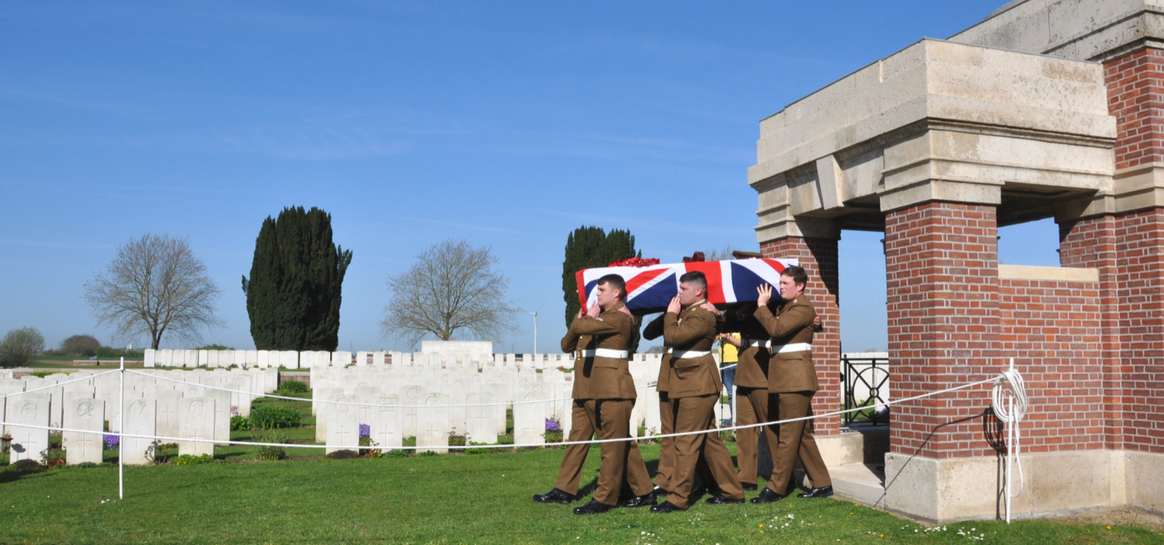18 April 2018
Seven First World War soldiers buried alongside their comrades

A burial service was held at the Commission’s New Irish Farm Cemetery this morning for Captain H J I Walker and six unknown soldiers, more than 100 years after their death.
Captain Henry John Innes Walker, of the Royal Warwickshire Regiment, was 25 years old when he was killed in action on 25 April 1915, during the Second Battle of Ypres.
He was found with a coin holder, binocular components and leather casing bearing the initials ‘HJIW’, plus a Royal Warwickshire Regiment cap badge and shoulder title, during a planned archaeological dig on the western side of the village of St Julien in April 2016. Multiple sets of remains were found during the dig, however despite extensive research it has only proved possible to identify him.

The service was attended by members of Capt Walker’s family, who he is known to as Jack, including his great nephews, Allan and Alistair Innes-Walker, who travelled from New Zealand and Australia respectively.
Allan Innes-Walker said: “According to his men, Jack's last words were 'Come on lads' as he raised his revolver and led his company towards German lines and heavy fire. His discovery and burial are a once-in-a-lifetime opportunity for my children to connect to a family member and a devastating history - an unexpected and inspiring legacy.”
Born on 12 February 1890 in Remuera, New Zealand, Henry attended Kings College where he played rugby as well as representing Auckland in interprovincial football and local athletics. In 1910 he was given a Second Lieutenant’s commission in the New Zealand Defence Force and a year later, in the British Army, where he enrolled with the Royal Warwickshire Regiment. His first posting was in India. In January 1915 he was promoted to the rank of captain and was twice mentioned in despatches.
Alistair Innes-Walker added: “My son is named after Great Uncle Jack. At school we sat beneath his memorial stained glass window - an ever-present reminder of a sad but proud history.”

The service was also attended by Greg Andrews, New Zealand Ambassador to Belgium and France, and Colonel James Phillips, the Defence Business Services Defence Attaché from the British Embassy in The Hague. Current members of the 1st Battalion The Royal Regiment of Fusiliers paid their own tribute by providing the bearer party.
Of the other six casualties, military insignia found with one of them confirms that he was a soldier of the Royal Warwickshire Regiment, although the regiment lost too many men at the time for individual identification to be attempted. He has been buried as an unknown soldier of the Royal Warwickshire Regiment. There were no military or personal effects found with any of the others; they have been buried as unknown soldiers of the Great War.
The CWGC provided the headstones and will care for their graves in perpetuity. Capt Walker’s headstone was engraved with his name and a personal inscription chosen by his family: “Beloved son and brother always remembered.”
The CWGC’s Mel Donnelly said: “Captain Walker was far from his New Zealand home, when he was killed in action in April 1915. He was a remarkable man, sent to serve with the British Army on behalf of his country, an outstanding athlete and a decorated officer. Today we have been able to lay him and his comrades to rest at the Commonwealth War Graves Commission’s New Irish Farm Cemetery, alongside the men they fought and died with. We remember his sacrifice and that of all those who served and will care for their graves and their memory with dedication, forever.”
The service, organised by the MOD’s Joint Casualty and Compassionate Centre, was led by the Reverend Stuart Richards CF, Chaplain to the 1st Battalion The Royal Regiment of Fusiliers.
Photo caption: image of Capt Walker © Innes-Walker family

